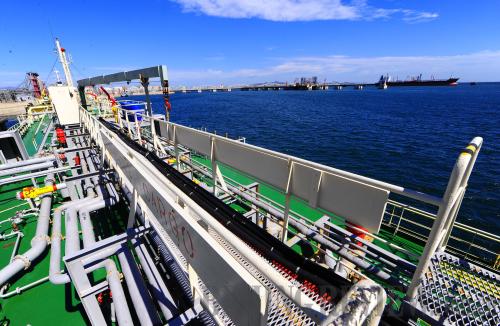|
 |
|
COASTAL ECONOMIC BELT: Dalian, incorporated in the Liaoning coastal economic belt, is accelerating establishing itself as an international shipping center in northeast Asia (REN YONG) |
An early version of a regional economic plan for the Xinjiang Uygur Autonomous Region is under scrutiny by the State Council, China's cabinet. The draft, which could be passed and implemented by May, will focus on the energy, tourism, iron and steel, new agriculture and recycling economy sectors in the autonomous region.
Xinjiang, China's largest provincial-level administrative region, lies in the country's northwestern forefront. The plan, therefore, is also expected to encourage border trade with neighboring Kazakhstan, Kyrgyzstan, Tajikistan, Uzbekistan and Turkmenistan and the establishment of economic cooperation areas, and to accelerate border trade and energy cooperation with Afghanistan and Pakistan.
For a more focused deliberation, 400 officials from the General Office of the State Council, the People's Bank of China, the National Development and Reform Commission, the State Taxation Administration and other government departments visited Xinjiang in November 2009 to gain first-hand insight.
The plan for Xinjiang will be the 13th regional economic development planning launched by the Chinese Government since 2009. In the past year, such plans were released on a monthly basis.
Creating a balance
Previous regional economic plans mainly covered coastal and inland areas in central and west China. Chen Xiushan, Director of the Institute of Regional Economics and Urban Management of the School of Public Administration at the Renmin University of China, said there are at least two deep considerations for the new approach: to nurture more regional economic growth pillars to ensure steady growth of the national economy; and to promote coordinated regional economic development and change the present imbalanced regional development in the long term.
Uneven regional development has long been a problem in China. According to Chen, after China adopted the reform and opening-up policy in 1978, policy obviously tilted in favor of coastal areas, which helped boost their development and also caused the development gap between coastal and interior regions.
From 1985 to 1995, China's paid-in capital totaled $149.95 billion, with the coastal area attracting $130.96 billion, or 87.3 percent of the total, and the central and western regions $12.71 billion and $6.29 billion respectively, or 8.5 percent and 4.2 percent of the national total.
Although a few trading ports have already been established in west China, the economies of adjacent countries are not well developed and cannot drive up development in China's border areas. Moreover, the natural conditions of east China are much better than those of west China, providing far more benefits for large-scale economic activities and industrial infrastructure. Particularly, the northwestern region faces severe droughts, a deteriorating ecological environment and infertile land, which put increasing burdens on its socio-economic development.
China's effort to switch from a planned economy to a market system, which began in 1978, also contributed to differentiations in the levels of system transformation in different localities, leading to imbalanced regional economic development. As a general rule of thumb, if the economy in a region is more denationalized, the economy will be more market-oriented. Hence, the proportion of the non-public economy and the development speed in east China is higher than inland areas, and east China's economy is also much more market-oriented than in west China.
The Central Government hopes to narrow the gap in regional development through regional economic revitalization. Aside from Xinjiang, regional planning for the Sichuan-Chongqing economic zone is also likely to be passed this year.
Chen said the regional planning approved by the Central Government is not entirely focused on granting favored policies or investment projects to these areas—it also endows more independent power to carry out systematic innovation and experiments.
| 